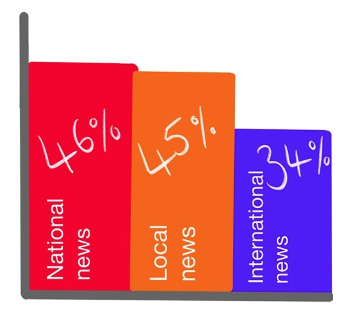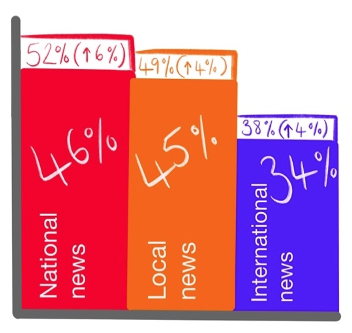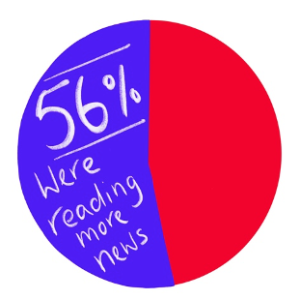Is it just us, or are you watching/reading/sharing more news than ever before? Keeping up with all things health, and global health news, is part of what we do every day at HAVAS Just::
So we were interested to find out what the stats are and see what impact COVID-19 is having on the businesses that are working hard to keep us all in the loop with the latest news.
We’ve been doing some digging, and it probably won’t surprise you to find out that news consumption has gone up. However, it might surprise you that some UK newspapers, and a once ‘it’ global online outlet, are struggling to keep their staff, closing UK offices and furloughing considerable numbers, with one leading UK newspaper losing their senior editorial team. Keep reading to find out which.
 In research published in April by CensusWide (which sampled national representative respondents aged 16+ in the UK)* it’s clear that all eyes are on the news. People from across the country are looking to be ‘in the know’ about COVID-19, and how it will impact them, their day-to-day lives and their loved ones.
In research published in April by CensusWide (which sampled national representative respondents aged 16+ in the UK)* it’s clear that all eyes are on the news. People from across the country are looking to be ‘in the know’ about COVID-19, and how it will impact them, their day-to-day lives and their loved ones.
When the sample group* was first asked what type of news they read at least once a week, results showed:
- 46% said national news
- 45% said local news
- 34% said international news
 When asked a second time* a week later, the numbers increased quite substantially:
When asked a second time* a week later, the numbers increased quite substantially:
- 52% said national news (up 6%)
- 49% said local news (up 4%)
- 38% said international news (up 4%)
You might be thinking that a 4% increase in the people reading international and local news isn’t much, but that’s the equivalent of over two million people.
Due to daily news briefings from the government, statistics updates, MPs going places and seeing people they shouldn’t, celeb-packed virtual concerts and amazing people doing amazing things (shout out to Captain Tom), there is more news to consume than ever  before, and people are lapping it up.
before, and people are lapping it up.
Coupled with the fact that many people are stuck inside with more time on their hands, it’s not surprising that in the group sampled, 56% were reading more news.
What about age groups? Is this increase exclusive to specific age groups? Yes, the most significant results show 16-24 year olds had a 15% increase (from 30% to 45%) in the number of people reading national news at least once a week.* This age group in particular is reading more news than usual; a 73% increase in fact!
55+’s are getting in on it too, with 40% saying they’re reading more news than usual.
From the data, we know news consumption is on the up, but what about the impact of COVID-19 on the news industry itself?
Over the last 10 years, print has become a dying news form, with more and more news online and accessible anywhere, anytime for free.
In fact, Ofcom said that national newspaper print circulation in the UK has decreased from 22 million in 2010 to 10.4 million in 2018, a decline of over 52%. As more and more people are able to access live news that is updated by the minute for free, online revenue for newspapers is dwindling, often resulting in reduced staffing, pay cuts and no bonuses.
Due to COVID-19 many UK news outlets are in the same difficult position as a lot of UK businesses, and are furloughing staff. The Guardian reported that between the Daily Mirror, Daily Express and Daily Star newspapers almost 1,000 staff are due to be furloughed (including the group’s senior editorial team).
It’s so bad for some that offices are being shut, with Buzzfeed announcing last week their UK and Australian offices will close. It seems that in the midst of a pandemic, people are even less interested in paying for their news.
Through researching and writing this post, we’ve been thinking about the impact of all of this on our news environment. With such high demand for vital news during this time, mixed in with news outlets reducing their staffing numbers, cutting editorial teams and closing local offices, will this negatively impact the speed, frequency and quality of our new? We’re interested to see what happens.
In the meantime, whilst this all plays out, something we’ve been thinking about is, if people are reading more news, what topics, themes and types of content do they enjoy or crave the most? So we set ourselves the challenge of looking into it. If you’re interested, check out more in part 2 of Keeping up with COVID-19.
*The first round of research was conducted by CensusWide, with a sample of 2,001 nationally representative respondents aged 16+ in the UK between 20.03.2020 – 23.03.2020. The second round of research was conducted by CensusWide, with a sample of 2,036 nationally representative respondents aged 16+ in the UK between 27.03.2020 – 30.03.2020.
**calculated based on ONS figures (2017): 53,534,872*0.04 = 2,141,395
***population number taken from Worldmeters, Slovenia population

